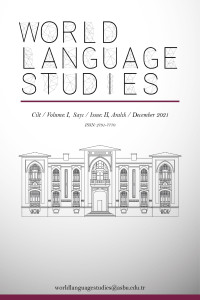Abstract
The most distinctive feature of Japanese and Turkish, which belong to the Ural-Altaic language family, is that they are agglutinative languages. The word is always derived or inflected with the suffixes it follows. Examples of this are the words book-çı in Turkish and hon-ya in Japanese for a word-affix word. Since the [-çı] and [-ya] suffixes in these words are derivational suffixes, these two languages show similarity to each other in word derivation. Since Japanese and Turkish both agglutinative languages, their word formations are also similar. However, consisting of Chinese characters (kanji), Japanese writing system results in both Japanese and Chinese pronunciations of words. Therefore, some Chinese origin words also derive new words with their additional function. For example, while the word “ie” means “home”, the word “honyakuka” derives a word though the pronunciation of [-ka]. This situation arouses curiosity about whether there are similarities or differences between Japanese and Turkish derivational suffixes. Therefore, in this study, it is aimed to compare the word structure and derivational suffixes in Turkish and Japanese. This comparison has shown that the Turkish suffix [-CI] has a very wide usage, as it covers all suffixes in Japanese with the meaning of "one who does a job". From this point of view, it is possible to say that Turkish can be learned more easily than Japanese. Also, from the Japanese point of view, the basic meaning of each word is reflected in the word with the "suffix" function, since Japanese has the lexical use of Kanjis. Therefore, in this study, it has been concluded that Japanese should be evaluated not only in terms of structure but also in terms of meaning and should be evaluated together with the semantic Kanji.
References
- Adalı, O. (1979). Türkiye Türkçesinde Biçimbirimler. Ankara: TDK. Akbay, O. H. (2011). Japonca Sözcük Öğretiminde Ekler. Kayseri: Laçin Yayınları. Atabay, N. (1976). Sözcük Türleri I. Ankara: TDK. Banguoğlu, H. T. (2000). Türkçenin Grameri. Ankara: TDK. Bloomfield, L. (1933). Language. Newyork: Holt, Rinehart and Winston. Dizdaroğlu, H. (1962). Türkçede Sözcük Yapma Yolları. Ankara: TDK. Ergin, M. (1986). Türk Dili. İstanbul: TDK. Gencan, T. N. (1961). Dilbilgisi. Ankara: Tdk. Hatipoğlu, V. (1974). Türkçenin Ekleri. Ankara: Ankara Üniversitesi. İmer, K. (1976). Türkiye Türkçesinde Kökler. Ankara : TDK. Katamba, F. (1993). Morphology. London: Macmillan Press Ltd. Kıran, Z. (1986). Saussure'den Günümüze dilbilim Akımları. Ankara: Onur Yabancı Diller Kitap ve Yayın Merkezi. Koizumi, T. (1993). Nihongo Kyōshino tameno Gengogaku Nyuumon. Tokyo: Taishuukan Shoten. Korkmaz, Z. (2003). Türkiye Türkçesi Grameri. Ankara: TDK. Machida, K., & Momiyama, Y. (1995). Yoku Wakaru Gengogaku Niyumon. Tokyo: Babel Press. Sakakura, A. (1995). Gokōsei no Kenkyuu (Sözcük Yapısı üzerine İnceleme). Tokyo: Kadokawa Shoten. Seyhan, A. (2004). Türkçe ve Japoncada Yapım Ekleri (sözcüğe meslek kavramı kazandıran ekler). Ankara: Ankara Üniversitesi, Sosyal Bilimler Enstitüsü Yüksek Lisans Tezi. Toklu, O. (2003). Dilbilime Giriş. Ankara: Akçağ Yayınevi. Vardar, B. (1998). Dilbilimin Temel KAvram ve İlkeleri. İstanbul: Multilingual.
Abstract
Ural-Altay dil ailesine mensup olan Japonca ve Türkçenin en belirgin özelliği sondan eklemeli dil olmalarıdır. Sözcük, her zaman ardına aldığı eklerle türetilir ya da çekime uğrar. Buna, sözcük-ek yapısındaki bir sözcük için Türkçede kitap-çı ve Japoncada hon-ya sözcükleri örnek verilebilir. Bu sözcükler üzerindeki [-çı] ve [-ya] ekleri türetme ekleri olduğundan sözcük türetmede bu iki dil birbiriyle benzerlik göstermektedir. Ancak, Japoncanın yazı sistemi Çince karakterlerden (kanji) oluşması, sözcüklerin hem Japonca hem de Çince okunuşlarını doğurmaktadır. Dolayısıyla bazı Çince kökenli sözcükler aynı zamanda ek işleviyle yeni sözcükler türetmektedir. Örneğin, “ie” sözcüğü “ev” anlamında iken, “honyakuka” sözcüğünde [-ka] okunuşuyla sözcük türetmektedir. Bu durum Japonca türetme ekleri ile Türkçe türetme ekleri arasında benzerlik ya da farklılıklar olup olmadığı konusunda merak uyandırmaktadır. Bu nedenle bu çalışmada Türkçe ve Japoncadaki sözcük yapısı ve türetme eklerinin karşılaştırılması amaçlanmıştır. Bu karşılaştırma Türkçedeki [-CI] ekinin “bir mesleği yapan kişi” anlamıyla Japonca tüm ekleri karşıladığı için çok geniş kullanımının olduğunu göstermiştir. Buradan hareketle Türkçenin Japoncaya göre daha kolay öğrenilebileceğini söylemek mümkündür. Ayrıca, Japonca açısından bakıldığında, Japoncada Kanjilerin eksel kullanımı söz konusu olduğundan, her bir sözcüğün temel anlamı “ek” işleviyle sözcüğe yansımıştır. Bu nedenle bu çalışmada Japoncanın sadece yapı açısından değil anlam açısından da ele alınarak anlambirim olan Kanji ile birlikte değerlendirilmesi gerektiği sonucuna varılmıştır.
References
- Adalı, O. (1979). Türkiye Türkçesinde Biçimbirimler. Ankara: TDK. Akbay, O. H. (2011). Japonca Sözcük Öğretiminde Ekler. Kayseri: Laçin Yayınları. Atabay, N. (1976). Sözcük Türleri I. Ankara: TDK. Banguoğlu, H. T. (2000). Türkçenin Grameri. Ankara: TDK. Bloomfield, L. (1933). Language. Newyork: Holt, Rinehart and Winston. Dizdaroğlu, H. (1962). Türkçede Sözcük Yapma Yolları. Ankara: TDK. Ergin, M. (1986). Türk Dili. İstanbul: TDK. Gencan, T. N. (1961). Dilbilgisi. Ankara: Tdk. Hatipoğlu, V. (1974). Türkçenin Ekleri. Ankara: Ankara Üniversitesi. İmer, K. (1976). Türkiye Türkçesinde Kökler. Ankara : TDK. Katamba, F. (1993). Morphology. London: Macmillan Press Ltd. Kıran, Z. (1986). Saussure'den Günümüze dilbilim Akımları. Ankara: Onur Yabancı Diller Kitap ve Yayın Merkezi. Koizumi, T. (1993). Nihongo Kyōshino tameno Gengogaku Nyuumon. Tokyo: Taishuukan Shoten. Korkmaz, Z. (2003). Türkiye Türkçesi Grameri. Ankara: TDK. Machida, K., & Momiyama, Y. (1995). Yoku Wakaru Gengogaku Niyumon. Tokyo: Babel Press. Sakakura, A. (1995). Gokōsei no Kenkyuu (Sözcük Yapısı üzerine İnceleme). Tokyo: Kadokawa Shoten. Seyhan, A. (2004). Türkçe ve Japoncada Yapım Ekleri (sözcüğe meslek kavramı kazandıran ekler). Ankara: Ankara Üniversitesi, Sosyal Bilimler Enstitüsü Yüksek Lisans Tezi. Toklu, O. (2003). Dilbilime Giriş. Ankara: Akçağ Yayınevi. Vardar, B. (1998). Dilbilimin Temel KAvram ve İlkeleri. İstanbul: Multilingual.
Details
| Primary Language | Turkish |
|---|---|
| Subjects | Language Studies |
| Journal Section | Research Articles |
| Authors | |
| Publication Date | December 30, 2021 |
| Submission Date | September 12, 2021 |
| Published in Issue | Year 2021 Volume: 1 Issue: 2 |

